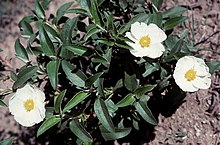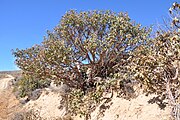Cistus laurifolius
| Cistus laurifolius | |
|---|---|

| |
| Scientific classification | |
| Kingdom: | Plantae |
| Clade: | Tracheophytes |
| Clade: | Angiosperms |
| Clade: | Eudicots |
| Clade: | Rosids |
| Order: | Malvales |
| Family: | Cistaceae |
| Genus: | Cistus |
| Species: | C. laurifolius
|
| Binomial name | |
| Cistus laurifolius | |
Cistus laurifolius, commonly called laurel-leaf cistus,[1] laurel-leaved cistus[2] or laurel-leaved rock rose, is a species of highly branched flowering evergreen shrub native to some areas around the Mediterranean. It grows 0.8–2 m (2 ft 7 in – 6 ft 7 in) high. The branches are strong and erect, with reddish bark that is easily removed in strips. The leaves are larger than in the other species of Cistus, up to 9 cm (4 in) long, lanceolate, dark green, while the underside is whitish due to trichomes. The flowering occurs in late spring (May–June), later than most rockroses.[3] It bears white flowers with a yellow spot in each petal, of 4.5–5 cm diameter[4] It is widely cultivated in gardens, and has gained the Royal Horticultural Society's Award of Garden Merit.[5]
Distribution and habitat
Cistus laurifolius has a disjunct natural distribution, in the Western Mediterranean area (Morocco, Portugal, Spain, southern France, Corsica and Tuscany), the Aegean[clarification needed] and Anatolia.[4]
With the general warming of the atmosphere and the consequent withdrawal of the ice, flora surviving from Tertiary times could not re-establish their range in southern Europe;[clarification needed] the new post-glacial climate was drier than that of the Tertiary. The original tropical European flora evolved into the present Mediterranean sclerophyll flora.[6][7][8] The distribution of some surviving species, such as Cistus laurifolius, moved to wetter areas such as the mountains.[8] Due to this, C. laurifolius is named in Spanish in its distribution area as "mountain rockrose",[8] although in the coastal west and northwest Iberian Peninsula, it is found at sea level.[9][dubious – discuss]
Cistus shrubland, including C. laurifolius, survives fire and has seeds that germinate after fire.[10]
Gallery
This section contains an unencyclopedic or excessive gallery of images. |
Subtaxa
- Cistus laurifolius var. atlanticus Pit.[11]
- Cistus laurifolius var. lanceolatus Rouy & Foucaud[citation needed]
- Cistus laurifolius var. laurifolius
- Cistus laurifolius var. ovatus Rouy & Foucaud[citation needed]
References
- ^ "Cistus laurifolius". Germplasm Resources Information Network. Agricultural Research Service, United States Department of Agriculture. Retrieved 16 January 2018.
- ^ "BSBI List 2007". Botanical Society of Britain and Ireland. Archived from the original (xls) on 2015-01-25. Retrieved 2014-10-17.
{{cite web}}: Unknown parameter|deadurl=ignored (|url-status=suggested) (help) - ^ Filippi, Olivier (2007). Pour un jardin sans arrosage (For a garden without irrigation). Arles: Actes Sud. p. 207. ISBN 978-2-7427-6730-4.
- ^ a b Flora Iberica 3: 331
- ^ http://apps.rhs.org.uk/plantselector/plant?plantid=430
- ^ John W. Harshberger (1926). "Mediterranean Garigue and Macchia (first page)". Proceedings of the American Philosophical Society. 65 (1): 56–63.
- ^ Fernández-Mazuecos, M.; Vargas, P. (2010). "Ecological rather than geographical isolation dominates Quaternary formation of Mediterranean Cistus species". Molecular Ecology. 19 (7): 1381–1395. doi:10.1111/j.1365-294x.2010.04549.x. PMID 20196815.
- ^ a b c Beatriz Guzmán; Pablo Vargas (2005). "Systematics, character evolution, and biogeography of Cistus L. (Cistaceae) based on ITS, trnL-trnF, and matK sequences" (PDF). Molecular Phylogenetics and Evolution. 37: 644–660. doi:10.1016/j.ympev.2005.04.026. PMID 16055353.
- ^ Antonio Rigueiro Rodríguez; Fco. Javier Silva-Pando. "Aportaciones A La Flora De Galicia, I." (PDF). Anales Jard. Bot. Madrid. 40 (2): 385–395.
- ^ R. Tárrega; E. Luis-Calabuig; I. Alonso (1997). "Space-time heterogeneity in the recovery after experimental burning and cutting in a Cistus laurifolius shrubland". Plant Ecology. 129: 179–187.
- ^ "Tropicos.org".




